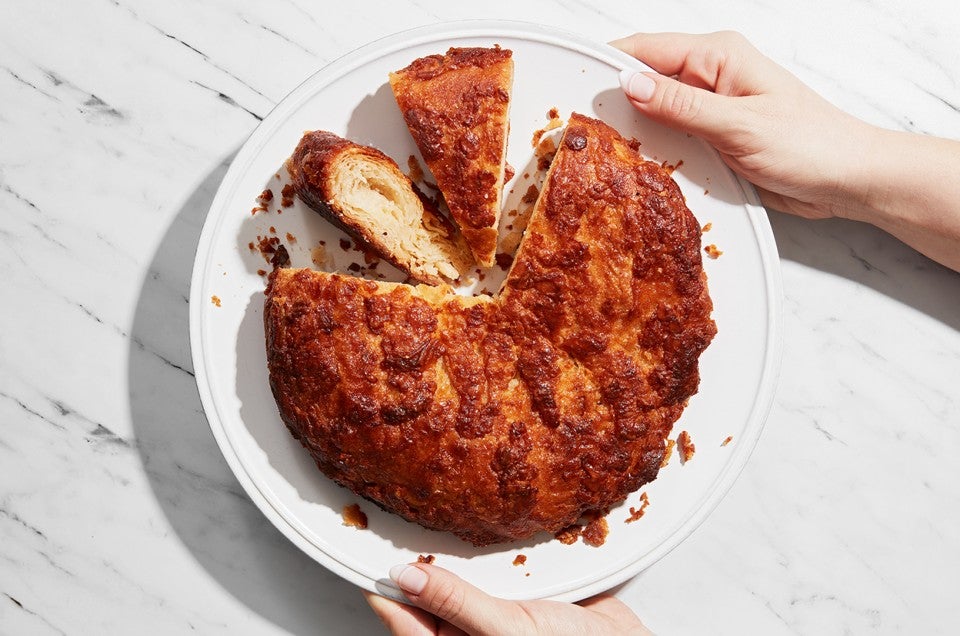This kouign-amann is faster, messier — and the way it was meant to be
Laminated pastries are notoriously challenging to pull off at home, but not this decadent Breton treat.


 It wasn’t long ago that nobody in the United States had heard of a kouign-amann, much less eaten one.
It wasn’t long ago that nobody in the United States had heard of a kouign-amann, much less eaten one.
But in 2022 — 10 years after Food & Wine crowned it “Pastry of the Year” — many Americans are familiar with the joys of this pastry’s buttery flakes and gooey, caramelized exterior.
But here’s the thing: While most renditions of this pastry are unquestionably delicious, the vast majority of them are not at all like the traditional version they make in Douarnenez, the tiny seaside town in which kouign-amann was invented in the mid-19th century.
If you don’t yet know this croissant-adjacent pastry, which hails from Brittany (the northwestern-most region of France), its name means “butter cake” in the Breton language and is pronounced queen ah-MANN. At its most basic, it’s a laminated, layered pastry made with salted butter and loads of sugar, which together seep out during the bake to form a caramelized, sticky exterior to complement the crispy, flaky crumb within. (Brittany is a coastal, verdant region known for its excellent sea salt and its happy cows, hence the use of salted butter in this pastry.)
What a kouign-amann is not is a croissant, though most American bakeries approach them as if they were. This is silly, really, because compared to croissants, kouign-amann take less time, less precision, less shaping, and generally less fuss.
Which brings me to perhaps the most striking difference between kouign-amann and croissants: kouign-amann are actually easy to make at home.
To understand how the real kouign-amann differs from the versions you’re familiar with (and why it’s easier to make), you need to first know the difference between this pastry and croissants.
To create the seemingly countless, flaky layers of a croissant, a slab of unsalted butter is first sealed inside an envelope of yeasted dough. The dough-butter packet is rolled out and folded over upon itself numerous times, which causes the butter and dough layers to multiply exponentially. When the croissant is baked, water in the butter turns to steam, causing the layers to separate and crisp up.
Croissant dough is usually chilled and rested in between each set of folds to allow the dough to relax and to keep the butter from softening; the whole process ("lamination") takes several hours. Once the lamination process is complete and the croissants are shaped, they're left to proof for at least a few hours (and often overnight) before baking.
To create a kouign-amann using this classic croissant method, bakeries usually just swap out salted butter for unsalted and add a coating of granulated sugar during the last set of rolling and folding the dough. Like croissants, the finished dough is cut up into pieces to form individual pastries. (Unlike croissants, kouign-amann aren't rolled into crescents but rather folded into petaled squares.)
Meanwhile, the traditional approach to making a kouign-amann — and the result — is decidedly more rustic.
It begins similarly, with butter encased in a yeasted dough — though in this case, the sugar is added along with it right from the start. Then, like croissants, the dough is rolled out and folded several times. The rolling, however, is done in a casual, almost haphazard manner, and the ensuing folds are done in quick 1-2-3 succession, without the hours of rest that croissant dough usually requires. (In fact, because the sugar is combined with the butter from the get-go, kouign-amann cannot be rested for very long before baking or the sugar will pull water from the dough and cause it to break down.)
To shape, the dough is formed into a wide round and nestled into a cake pan instead of being cut into individual pieces. Its top surface is scored quickly with a knife into a crosshatch pattern, brushed with milk or egg, then sent straight to the oven to bake.
The whole process — including the two-ish hours to proof the initial dough and the 45-minute bake — takes just a few hours from start to finish (as opposed to the days-long effort that many croissant and croissant-style kouign-amann recipes require).
The result isn't something you might refer to as delicate, but it is sublime. Kouign means cake, but this only really resembles a cake in shape and size (and the way it’s cut into wedges to serve). With fewer sets of folds and a shorter fermentation than a croissant-style kouign-amann, this original version is sturdy and compact rather than light and ethereal. But it still retains that signature kouign-amann sticky-toffee coating along with a satisfying, crunchy exterior and peel-apart sheets of moist, tender bread within.
I had my first real kouign-amann at the Canadian-Breton bakery Au Kouing-Amann [sic] in Montréal about 10 years ago, and I’ve been obsessed with it ever since.
Since this style of kouign-amann is so hard to come by, and because neither Brittany nor Montréal are at all convenient to me, I was left with no choice but to sort out a recipe of my own. And since I couldn’t travel for research, I did the next best thing: I took to YouTube, where I found a surprisingly large number of videos demonstrating how kouign-amann is made in Douarnenez. After a few solid months of trial and error — and countless pounds of flour, sugar, and salted butter — I finally had a recipe that scratched my pastry itch.
Everything I do in my recipe I saw other bakers do in videos, though mine is a mash-up of multiple recipes, based on what was easy and still gave the best results in my kitchen. Here are the key details:
The most important piece of advice I have for someone approaching this recipe for the first time is this: Do not stress out! Real kouign-amann is one of the most forgiving laminated pastries there is. It’s made in a casual, almost cavalier manner, and still comes out of the oven beautifully. If the dough tears and the butter starts to leak out during rolling, just coat it with flour and carry on. I promise it will be fine!
The second most important piece of advice I have: Use tons of flour on the exterior of your dough while you work, to keep it from sticking to the counter or the rolling pin. (Kouign-amann pros work on absolute piles of flour.) You can simply brush off the excess at the end of each step.
Finally, this classic kouign-amann is very forgiving in terms of its appearance. Even the messiest-looking ones clean up wonderfully once baked. Don’t fret if yours is shaggy or unkempt before it goes into the oven; it’s sure to be (rustically) beautiful when it comes out. When it does, it may not look like the kouign-amann you’re familiar with, but it will probably become your preferred version — just like in Brittany.
Cover photo by Joseph De Leo.